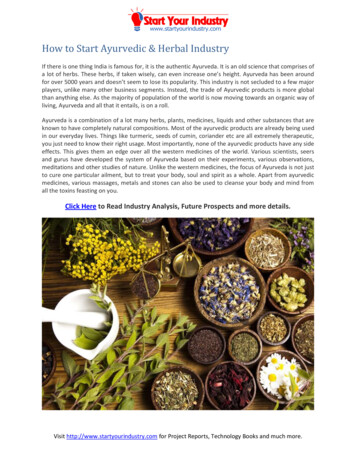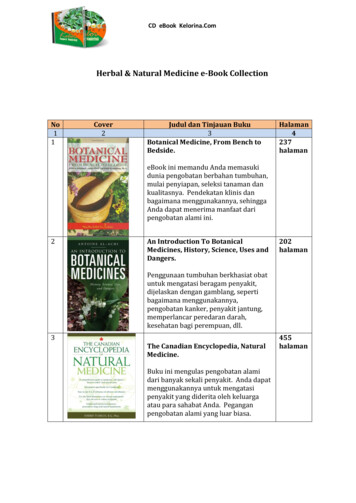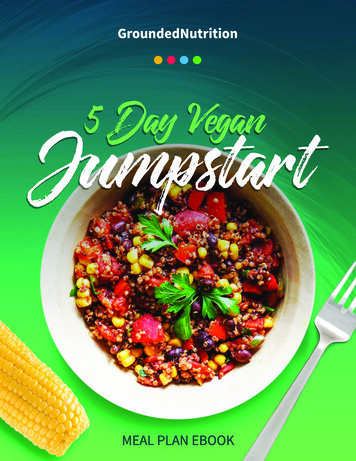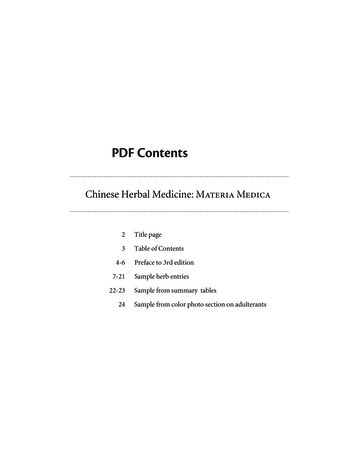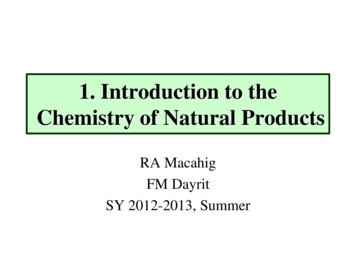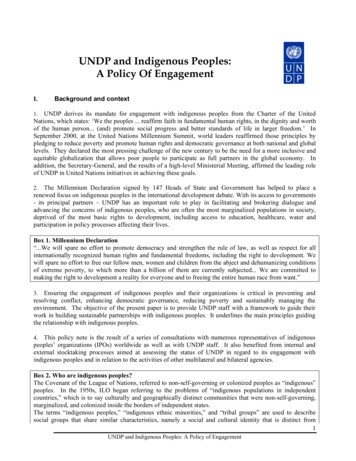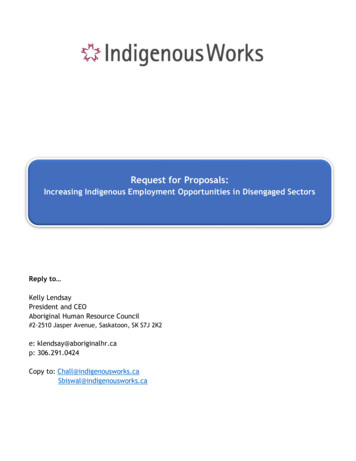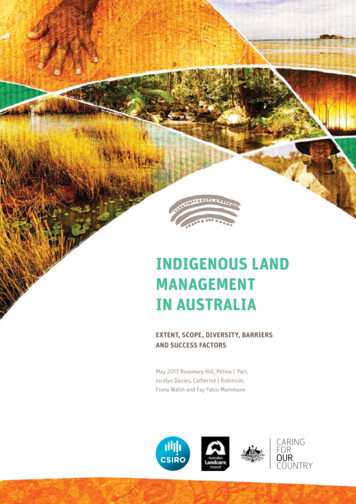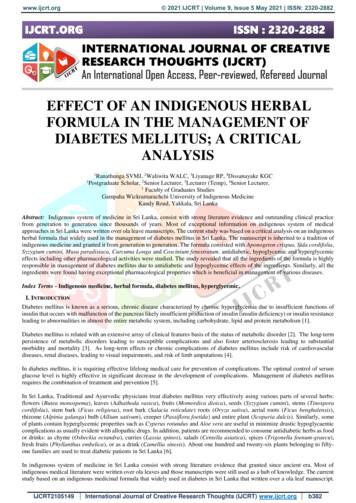
Transcription
www.ijcrt.org 2021 IJCRT Volume 9, Issue 5 May 2021 ISSN: 2320-2882EFFECT OF AN INDIGENOUS HERBALFORMULA IN THE MANAGEMENT OFDIABETES MELLITUS; A CRITICALANALYSIS1Ranathunga SVMJ, 2Waliwita WALC, 3Liyanage RP, 4Dissanayake KGCPostgraduate Scholar, 2Senior Lecturer, 3Lecturer (Temp), 4Senior Lecturer,1Faculty of Graduates StudiesGampaha Wickramarachchi University of Indigenous MedicineKandy Road, Yakkala, Sri Lanka1Abstract: Indigenous system of medicine in Sri Lanka, consist with strong literature evidence and outstanding clinical practicefrom generation to generation since thousands of years. Most of exceptional information on indigenous system of medicalapproaches in Sri Lanka were written over ola leave manuscripts. The current study was based on a critical analysis on an indigenousherbal formula that widely used in the management of diabetes mellitus in Sri Lanka. The manuscript is inherited to a tradition ofindigenous medicine and granted it from generation to generation. The formula consisted with Aponogeton crispus, Sida cordifolia,Syzygium cumini, Musa paradisiaca, Curcuma Longa and Coscinium fenestratum. antidiabetic, hypoglycemic and hyperglycemiceffects including other pharmacological activities were studied. The study revealed that all the ingredients of the formula is highlyresponsible in management of diabetes mellitus due to antidiabetic and hypoglycemic effects of the ingredients. Similarly, all theingredients were found having exceptional pharmacological properties which is beneficial in management of various diseases.Index Terms - Indigenous medicine, herbal formula, diabetes mellitus, hyperglycemic.I. INTRODUCTIONDiabetes mellitus is known as a serious, chronic disease characterized by chronic hyperglycemia due to insufficient functions ofinsulin that occurs with malfunction of the pancreas likely insufficient production of insulin (insulin deficiency) or insulin resistanceleading to abnormalities in almost the entire metabolic system, including carbohydrate, lipid and protein metabolism [1].Diabetes mellitus is related with an extensive array of clinical features basis of the status of metabolic disorder [2]. The long‐termpersistence of metabolic disorders leading to susceptible complications and also foster arteriosclerosis leading to substantialmorbidity and mortality [3]. As long-term effects or chronic complications of diabetes mellitus include risk of cardiovasculardiseases, renal diseases, leading to visual impairments, and risk of limb amputations [4].In diabetes mellitus, it is requiring effective lifelong medical care for prevention of complications. The optimal control of serumglucose level is highly effective in significant decrease in the development of complications. Management of diabetes mellitusrequires the combination of treatment and prevention [5].In Sri Lanka, Traditional and Ayurvedic physicians treat diabetes mellitus very effectively using various parts of several herbs:flowers (Butea monospema), leaves (Adhathoda vasica), fruits (Momordica dioica), seeds (Syzygium cumini), stems (Tinosporacordifolia), stem bark (Ficus religiosa), root bark (Salacia reticulate) roots (Oryza sativa), aerial roots (Ficus benghalensis),rhizome (Alpinia galanga) bulb (Allium sativum), creeper (Passiflora foetida) and entire plant (Scoparia dulcis). Similarly, someof plants contain hyperglycemic properties such as Cyperus rotundus and Aloe vera are useful in minimize drastic hypoglycaemiccomplications as usually evident with allopathic drugs. In addition, patients are recommended to consume antidiabetic herbs as foodor drinks: as chyme (Osbeckia octandra), curries (Lassia spinos), salads (Centella asiatica), spices (Trigonella foenum-graecu),fresh fruits (Phyllanthus embelica), or as a drink (Camellia sinesis). About one hundred and twenty-six plants belonging to fiftyone families are used to treat diabetic patients in Sri Lanka [6].In indigenous system of medicine in Sri Lanka consist with strong literature evidence that granted since ancient era. Most ofindigenous medical literature were written over ola leaves and those manuscripts were still used as a hub of knowledge. The currentstudy based on an indigenous medicinal formula that widely used in diabetes in Sri Lanka that written over a ola leaf manuscript.IJCRT2105149International Journal of Creative Research Thoughts (IJCRT) www.ijcrt.orgb382
www.ijcrt.org 2021 IJCRT Volume 9, Issue 5 May 2021 ISSN: 2320-2882The study critically analyzed the pharmacological activities of the ingredients in selected formula in the management of diabetesmellitus.Selected Ola Leaves ManuscriptThe manuscript was written by Mohandiram Ralahami who was traditional Ayurveda medical practitioner, born in 1872. And itwas granted by Dr. U. A. Algama. This manuscript consists 300 pages and 18 cm long, width is 5cm. It includes multiple medicalformulas which are related to various kind of diseases. Among those formulas the following herbal formulation (Table 1) decoctionwas selected to treat diabetes mellitus.Table 1: Herbal formulationScientific nameAponogeton crispusSida cordifoliaSyzygium cuminiMusa paradisiacaCurcuma LongaCoscinium fenestratumFamily ingiberaceaeMenispermaceaeSinhala nameKekatiyaBabilaMadanAlu KeselViyali KahaVenival GataSanskrit nameAmbuvallikaBalaJambuKadaliNishaDaru HaridraPart of useTuberRootBarkAlukesel MuhaRhizomesWhole PlantII. PHARMACOLOGICAL REVIEWAponogeton crispus – Kekatiya (tubers)Leaves of A. crispus grow up to 20 inches long. Leaf edges are rippled and extremely wavy. Single-spiked flowers are white, selffertile and easy to propagate. Leaves of A. crispus grow up to 20 inches long. Leaf edges are rippled and extremely wavy. Singlespiked flowers are white, self-fertile and easy to propagate [7].The phytochemical constituents of the Aponogeton species were found to be comprised of various polyphenolic compoundsflavonoids, flavones alkaloids, tannin, saponin, sesquiterpene and glycosides [7].The plant consists with an antioxidant activity which has always been acknowledged as a powerful source of natural antioxidantsfrom an ancient period of times. In Asia, many of the indigenous aquatic plants of the genus Aponogeton are extensively used intraditional medicine and various research works were done to investigate the bioactivity and phytochemical constituents. Tubersand whole plants of Aponogeton crispus is used for treatments of burning sensation of the body, wounds, heart disease, excessivethirst, nausea and diabetes mellitus. The herb effective in reduction of aggravated pitha dosha and increases vatha and kapha doshaand improves vision [7].Anti- diabetes action among Aponogeton species A. appendiculatus, A. natans, A. crispus possesses antidiabetic property [8-10].A literature review revealed that Aponogeton natans Linn. leaf extracts can be used as an antidiabetic agent. This activity wasexperimented by Oral Glucose Tolerance Test in alloxan-induced diabetic rats [7].Sida cordifolia – babila (roots)Sida cordifolia is a small, erect, downy shrub. Leaves of the plant are cordate-oblong or ovate oblong and fruits with a pair of awnseach carpel. Root of the plant which constitute a drug are 5-15 cm long with few lateral roots of smaller size. The tap roots aregenerally branched at the tip [11].Phytochemical constitutions of the plant has been found as Ephedrine, Pseudoephedrine, Sterculic, malvalic and coronaric acid,Fatty acids, Saponine, Betaphenethylamine, Hypaphorine, Ecdysterone, Indole alkaloids, Palmitic, stearic and β – sitosterol [11].In the Ayurvedic system of medicine, it is used as antirheumatic, analgesic, antipyretic, antiasthmatic, nasal anticongestant, antiviral,laxative, diuretic, aphrodisiac, hypoglycemic, hepatoprotective and in the treatment of Parkinson’s disease. Bala, is used to treatbronchial asthma, cold and flu, chills, lack of perspiration, headache, nasal congestion, aching joints and bones, cough andwheezing, and edema. The root infusion is given in nervous and urinary diseases and also in disorders of the blood and bile. Sidacordifolia has been reported to possess analgesic, anti-inflammatory and hypoglycemic activities as well as hepatoprotectiveactivity. Traditionally, the plant Sida cordifolia (linn) syn has been used as central nervous system depressant, loose fat, analgesics,anti-inflammatory, hypotensive, and hepatoprotective agent. Presence of ephedrine has highlighted the utility of this plant. Variouspharmacological preparation of this plant has been widely used in asthma diseases, overweight, obesity and as an energy booster,Similarly, used for management of pain, swellings, and heart diseases [12].This plant has Antidiabetic activity. Kanth and Diwan was studied hypoglycemic, analgesic and anti-inflammatory activities withaerial and roots of Sida cordifolia extracts. Mahrukh Ahmad was evaluated hypoglycemic, anti-hyperlipidemia and antioxidantpotential of alcoholic extract of Sida cordifolia at a dose of (200 and 400 mg/kg) in streptozotocin- induced diabetes rats at thedose of 55 mg/kg. At a dose of 400 mg/kg Sida cordifolia extracts showed significant reduction of the blood glucose level indiabetic rats and there was a decrease in total cholesterol, triglycerides, low density lipid, plasma-creatine, plasma-urea nitrogen.There was a significant increase in antioxidant enzymes such as catalase and superoxide-dismutase activity were observed [13].IJCRT2105149International Journal of Creative Research Thoughts (IJCRT) www.ijcrt.orgb383
www.ijcrt.org 2021 IJCRT Volume 9, Issue 5 May 2021 ISSN: 2320-2882Syzygium cumini – Madan (bark)Syzygium cumini is a large evergreen and densely foliaceous tree with greyish-brown thick bark, exfoliating in woody scales. Thewood is whitish, close grained and durable; affords brown dyes and a kind of a gum Kino. The leaves are leathery, oblong-ovate toelliptic or obovate-elliptic with 6 to 12 centimeters long, the tip being broad and less acuminate. Flowers are scented, greenishwhite, in clusters of just a few or 10 to 40 and are round or oblong in shape and found in dichotomous paniculate cymes. The fruitsare berries and are often obviously oblong, 1.5 to 3.5 centimeters long, dark-purple or nearly black, luscious, fleshy, and edible; itcontains a single large seed. The plant produces small purple plums, which have a very sweet flavor, turning slightly astringent onthe edges of the pulp as the fruit becomes mature [14].The roots are rich in flavonoid glycosides and isorhamnetin 3-O-rutinoside. The leaves are rich in acylated flavonol glycosides,quercetin, myricetin, myricitin, myricetin 3-O-4-Acetyl-L-rhamnopyranoside, triterpenoids, esterase, galloyl carboxylase, andtannin. The stem bark is rich in betulinic acid, friedelin, epi-friedelanol, β-sitosterol, eugenin and fatty acid ester of epi-friedelanol,β-sitosterol, quercetin kaempferol, myricetin, gallic acid and ellagic acid, bergenins, flavonoids and tannins. The presence of galloand ellagi-tannins. The fruits are rich in raffinose, glucose, fructose, citric acid, mallic acid, gallic acid, anthocyanins; delphinidin3-gentiobioside, malvidin-3-laminaribioside, petunidin-3-gentiobioside, cyanidin diglycoside, petunidin and malvidin. Thesourness of fruits may be due to presence of gallic acid [14].All parts of the plant can be used medicinally including cough, diabetes, dysentery, inflammation and ringworm. Similarly, differentparts of the plant have been used in the treatment of diabetes, blisters in mouth, cancer, colic, diarrhea, digestive complaints,dysentery, piles, pimples and stomachache. The bark is acrid, sweet, digestive, astringent to the bowels, anthelmintic and used forthe treatment of sore throat, bronchitis, asthma, thirst, biliousness, dysentery and ulcers. It is also a good blood purifier. The fruit isacrid, sweet, cooling and astringent to the bowels and alleviate halitosis, biliousness, stomachic, astringent, diuretic and antidiabeticproperties are available [14].In the early 1960s to 1970s, some preliminary reports on the antidiabetic activity of different parts of the plant in diabetic animalswere reported. It is widely distributed throughout India and Indian folk medicine that has been mentioned its uses for the treatmentof diabetes mellitus. Various traditional practitioners in India use the different parts of the plant in the treatment of diabetes [14].Musa paradisiaca – Alukesel (Alukesel muha)Musa paradisiaca is an herbaceous plant up to 9 m long with a robust treelike pseudo stem, a crown of large elongated oval deepgreen leaves (up to 365 cm in length and 61 cm in width), with a prominent midrib, each plant produces a single inflorescence likedrooping spike, and large bracts opening in succession, ovate, 15-20 cm long, concave, dark red in color and somewhat fleshy.Fruits are oblong, fleshy, 5-7cm long in wild form and longer in the cultivated varieties. Musa sapientum is a treelike perennial herbthat grows 5 - 9 m in height, with tuberous rhizome, hard, long pseudo stem. The inflorescence is big with a reddish-brown bractand is eaten as vegetables. The ripe fruits are sweet, juicy and full of seeds and the peel is thicker than other banana [15].Phytochemical constitution has been found consisting Catecholamines such as norepinephrine, serotonin, dopamine, tryptophan,indole compounds, pectin have been found in the pulp. Several flavonoids and related compounds (Leucocyanidin, quercetin andits 3-Ogalactoside, 3-O-glucoside, and 3-O-rhamnosyl glucoside) were isolated from the unripe pulp of plantain. Serotonin, norepinephrine, tryptophan, indole compounds, tannin, starch, iron, crystallisable and non-crystallisable sugars, vitamin C, B-vitamins,albuminoids, fats, mineral salts have been found in the fruit pulp of M. paradisiaca and M. sapientum. Acyl steryl glycosides suchas sitoindoside-I, sitoindoside-II, sitoindoside-III, sitoindoside-IV and steryl glycosides such as sitosterol gentiobioside, sitosterolmyo-inositylβ-D-glucoside have been isolated from fruits of M. paradisiaca [15].Plant used to treat peptic ulcer disease. It showed antimicrobial activity against Staphylococcus and Pseudomonas species indehydrogenase assay. The green fruit of M. paradisiaca has been reported to have hypoglycemic effect due to stimulation of insulinproduction and glucose utilization, Flavonoids isolated from unripe fruits showed. Hypolipidemic activity, antihypertensive effect,wound healing activity, diuretic activity, antimalarial activity and antioxidant activity were also reported [15].The Antidiabetic activity of the flowers has been reported in the literature, but not studied systematically all parts of the M.paradisiacal (Linn.) [16]. A comparative evaluation of the antidiabetic and hypoglycemic potential of the extracts from differentplant parts of Musa paradisiaca (MP) was carried out in vitro. MP extracts were prepared sequentially with methanol, chloroformand petroleum ether. A comparison was made between the action of extracts from different parts. Different concentrations of eachextract were made by using phosphate buffer and subjected to αamylase and α-glucosidase inhibitory assays using maltose and 2Chloro-4-Nitrophenyl-α-Maltotrioside as substrates respectively. Using this method, the percentage of α-amylase inhibitoryactivities of each extract were calculated. The enzymes were extracted from the sheep intestines. The absorbencies ware read at 595nm and 405nm respectively using spectrophotometer. Methanol extracts were found to show higher inhibition. It was found thatfruit and stem extract showed high rate of inhibition. At 100 μg/ml concentration of the stem extract a high of 83% inhibition of αamylase was recorded. A high of 80% inhibition was recorded for α-glucosidase activity when 100 μg/ml of stem extracts wereused. Leaf and flower extracts were also good in Index Terms- Musa paradisiaca, antidiabetic, diabetic mellitus, hypoglycemic[17].IJCRT2105149International Journal of Creative Research Thoughts (IJCRT) www.ijcrt.orgb384
www.ijcrt.orgCurcuma longa – Viyali kaha (Rhizomes) 2021 IJCRT Volume 9, Issue 5 May 2021 ISSN: 2320-2882Is a member of the ginger family (Zingiberaceae) a perennial herb, with a short stem, tufted leaf and the rhizomes, which are shortand thick and from root to leaves about 2 feet long, deeply veined leaves that project upward from stems that grow from the baseof the plant. The leaf color is deep green and the surface is glossy and smooths. The flowers range from white to light yellow andform a tall spike. The rhizomes, specialized underground stems that are root-like in structure have a brown surface and bright orangeor yellow interior flesh and after cutting, it is in curved cylindrical or oblong tubers 2 or 3 inches in length, and an inch in diameter,pointed or tapering at one end, yellowish externally, with transverse, parallel rings internally deep orange or reddish brown, markedwith shining points, dense, solid, short, granular fracture, forming a lemon yellow powder [18].Phytochemical constitutions were found as flavonoid, alkaloid, saponin, terpenoid, quercetin, tannin, essential oil, phenol, catechinand coumarin [19].Plant has been used for inflammatory conditions and diseases such as biliary disorders, anorexia, cough, diabetic wounds, hepaticdisorders, rheumatism and sinusitis, antioxidant, antineoplastic, antiviral, anti-inflammatory, antibacterial, antifungal, antidiabetic,anticoagulant, antifertility, cardiovascular protective, hepatoprotective, and immunostimulant activity in animals [19].Curcuma longa rhizome extract showed blood glucose lowering activity in experimental, induced- diabetic rats. Curcumin treatmentalso significantly reduced macrophage infiltration of white adipose tissue, increased adipose tissue adiponectin production, anddecreased hepatic nuclear factor-kappa B activity, hepatomegaly, and markers of hepatic inflammation. We therefore conclude thatorally ingested curcumin reverses many of the inflammatory and metabolic derangements associated with obesity and improveglycemic control in case of diabetic rat [20].Coscinium fenestratum – Venivelgata (whole plant)A large dioecious liana up to 10 m long, with yellow wood and sap. The stem and root slices are hard and woody. Wood isyellowish-brown in color externally and yellow internally. The drug occurs in large woody, cylindrical, straight pieces,sometimes as much as 10 cm in diameter. Leaves simple, alternate, exstipulate, broadly ovate, rounded, truncate or shallowlycordate at base, acuminate at apex, 10-32x8-22 cm [21].The major alkaloids are yellow crystalline berberine, protoberberine and jatrorrhizine. Many other alkaloids, mainly of theprotoberberine type, isolated from stem and root which were magnoflorine, berberrubine, thalifendine, palmitine andoxyberberine. The stem and root also contain ceryl-alcohol, saponin, hentriacontane, sitosterol, palmitic acid, oleic acid andsitosterol glucoside [21].The drug is useful in vitiated conditions of kapha and vata, inflammations, wounds, ulcers, jaundice, burns, skin diseases,abdominal disorders, diabetes, fever and general debility. An infusion, tincture and concentrated liquor are also prepared towash wounds and skin rashes. Stem pieces are boiled and one cup is given in case of a fresh, deep cut, being the mostcommon use against tetanus. Decoction of stem is given internally in cases of bites from mon keys, snakes, brahmin-lizardsand geckos. The root bark is used for dressing wounds, ulcers and in cutaneous leishmaniasis. It is known to treat influenzaand eye diseases. Simply boiling the pieces and bathing with the water relieves body pain. Coscinium is also used to treatbleeding piles and excessive bleeding during menstruation. For snakebite poisoning, paste of Coscinium and turmeric isapplied [21].The antihyperglycemic potential of the aqueous stem extract of Coscinium fenestratum, widely used in traditional Ayurveda andSidhda system of medicine for the treatment of diabetes mellitus, was evaluated in the streptozotocinnicotinamide–induced type 2diabetic model. In extract-treated diabetic rats, an insulin-independent action with significant reduction in blood glucose, serumtriglycerides and cholesterol level were observed [22].III. CONCLUSIONThe Indigenous medicinal formula consisted with Aponogeton crispus, Sida cordifolia, Syzygium cumini, Musa paradisiaca,Curcuma Longa and Coscinium fenestratum elaborated antidiabetic, hypoglycemic effects including other pharmacologicalactivities due to the consistence of rich phytochemistry and other chemical compounds. The study revealed that all the ingredientsof the formula is highly responsible in management of diabetes mellitus due to antidiabetic and hypoglycemic effects of theingredients. Similarly, all the ingredients were found having exceptional pharmacological properties which is beneficial inmanagement of various diseases.IJCRT2105149International Journal of Creative Research Thoughts (IJCRT) www.ijcrt.orgb385
www.ijcrt.orgREFERENCES 2021 IJCRT Volume 9, Issue 5 May 2021 ISSN: 2320-2882[1]. Diagnosis and Classification. WHO. (1999). Definition, Diagnosis and Classification of Diabetes Mellitus and itsComplications. of Diabetes Mellitus (WHO/NCD/NCS/99.2), Geneva: World Health Organization; p 2.[2]. Seino Y., Nanjo.K., Tajima N., Kadowaki T., Kashiwagi A., Ueki K., (2010). Report of the Committee on the Classificationand Diagnostic Criteria of Diabetes Mellitus, Journal of Diabetes Investigation. 1(5): 212–228.[3]. Demmer R.T., Zuk A.M., Rosenbaum M., and Desvarieux M. (2013). Prevalenceof Diagnosed and Undiagnosed Type 2Diabetes Mellitus Among US Adolescents: Results from the Continuous NHANES 1999–2010, American Journal ofEpidemiology, 178(7): 1106–1113.[4]. Reinehr T., (2013). Type 2 diabetes mellitus in children and adolescents, World Journal of Diabetes, 4(6), 270–281.[5]. De Silva A.P., De Silva S.H.P., Haniffa R., Liyanage I.K., Jayasinghe K.S.A., Katulanda P., Rajapakse L.C., (2016). Asurvey on socioeconomic determinants of diabetes mellitus management in a lower middle-income setting, InternationalJournal for Equity in Health, 15, 74.[6]. Ediriweera ERHSS, Rathnasooriya WD, (2009). A Review on Herbs Used in treatment of Diabetes Mellitus by Sri LankanAyurvedic and Traditional Physicians, AYU An International Quarterly Journal of Research in Ayurveda, 30(4), 373-391.[7]. Nargis S.C., Tamima B.I., Farhana F., Sifat J., (2019). Pharmacological Values and Phytochemical Analysis of AquaticPlant Genus Aponogeton, A Review-2019, International Journal of Recent Innovations in Academic Research, 3(3), 125141.[8]. Jyothi, K.J. Sunil, C.N. 2018. GC-MS analysis and nutrient evaluation of rare endemic and threatened species- Aponogetonappendiculatus V. Bruggen of South India. Indian Journal of Scientific Research, 20(1): 07-11.[9]. Dash, S., Kanungo, S.K. and Dinda, S.C. 2014. Antidiabetic activity of Aponogeton natans (Linn.) Engl. & Krause—animportant folklore medicine. International Journal of Pharmacy and Pharmaceutical Sciences, 6(1): 574-577.[10]. Isuru, R.G.A., Hettiarachchi, D., Jayasuriya, W.J.A.B.N. and Suresh, T.S. 2016. Hypoglycaemic activity of aponogetoncryspus in normal rats. Proceedings of 3rd Ruhuna International Science and Technology Conference University of Ruhuna,Matara, Sri Lanka January 28, 2016.[11]. Ankit J., Shreya C. Singour P.K, Rajak H., Pawar R.S., (2011). Sida cordifolia (Linn) An Overview, Journal of AppliedPharmaceutical Science 01 (02), 2011: 23-31.[12]. Galal A., Raman., Vijayasankar., Khan A., (2015). Sida cordifolia, a Traditional Herb in Modern Perspective – A Review,Current Traditional Medicine, 1(1), DOI: [13]. Srinithya B., Meenakshi S.M., (2014). An overview on the biological perspectives of Sida cordifollia Linn. InternationalJournal of Pharmacy and Pharmaceutical Science, 6(11), 15-17.[14]. Muniappan A., Pandurangan S., (2012). Syzygium cumini (L.) Skeels: A review of its phytochemical constituents andtraditional uses, Asian Pac J Trop Biomed 2012, Mar; 2(3): 240–246.[15]. Mohammad Z., Saleha A., (2011). Musa paradisiaca L. and Musa sapientum L.: A Phytochemical and PharmacologicalReview., Journal of applied pharmaceutical science, 1(5), 14-20.[16]. Vijai L., Agarwal S.K., Jamal A.A., Abbas A.M., Arvind K., (2014), Antidiabetic potential of Musa paradisiaca inStreptozotocin- induced diabetic rats, The journal of phytopharamacology, 2014, 3(2): 77-81.[17]. Jayarama R., Jeldi H., Comparative evaluation of the antidiabetic and hypoglycaemic potentials of the parts Musaparadisiaca plant extracts. International Journal of Scientific Research and Publications, 4(4): 1-5.[18]. Nitesh K. Sunil K.S., Ethno pharmacological Properties of Curcuma longa: A review Department of VeterinaryPharmacology and Toxicology, College of Veterinary Science and A. H., Rewa – 486001 Madhya Pradesh, India.[19]. Wei Z., Zhe L., Hang M., Sophia O.E., Patrick N.O., (2018). Analysis of C. Colebr stem extract and effect of the extracton mean arterial blood pressure, heart rate and force of contraction in rats, Tropical Journal of Pharmaceutical ResearchJune 2018, 17 (6): 1073-1080.[20]. Ghorbani Z, Hekmatdoost A, Mirmiran P., (2014). Anti-Hyperglycemic and Insulin Sensitizer Effects of Turmeric and ItsPrinciple Constituent Curcumin. International Journal of Endocrinology Metabolism, 12(4), e18081.[21]. Tushar K.V., Satheesh G., Remasheer A.B., Indra B., (2008). Coscinium fenestratum (Gaertn) Colber – A Review on thisRare, Critically Endangered and Highly-Traded Medicinal Species., Journal of Plant Sciences, 3(2), 133-145, 2008.[22]. Annie S., Rajendran K., Punitha I.S.R., (2005). Antihyperglycemic Activity of the Aqueous Stem Extract of Cosciniumfenestratum in Non–insulin Dependent Diabetic Rats2005, 43(8), 707–712.IJCRT2105149International Journal of Creative Research Thoughts (IJCRT) www.ijcrt.orgb386
Musa paradisiaca - Alukesel (Alukesel muha) Musa paradisiaca is an herbaceous plant up to 9 m long with a robust treelike pseudo stem, a crown of large elongated oval deep-green leaves (up to 365 cm in length and 61 cm in width), with a prominent midrib, each plant produces a single inflorescence like
